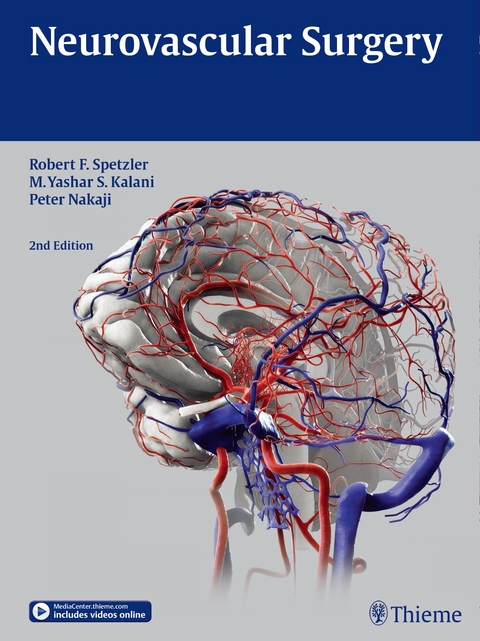
Neurovascular Surgery
Thieme Medical Publishers (Verlag)
978-1-60406-759-0 (ISBN)
Written by 21st Century pioneers in the field, this second, cutting-edge edition offers the latest science throughout 1,400 pages and a remarkable video library covering anatomy, diagnosis, epidemiology, history, treatment indications, technical nuances, outcomes, and complications. Internationally renowned experts from across the globe share clinical pearls and best practices,from the research lab to the ER to the OR.
Medical, surgical, endovascular, cerebral revascularization, bypass surgery, radiation therapy, and other procedures are covered in depth. Evidence-based and transdisciplinary, the second edition covers the full spectrum of neurovascular pathologies,preoperatively and postoperatively, including:
- Ischemic Stroke and Vascular Insufficiency
- Cerebral and Spinal Aneurysms
- Cerebral Spinal Arteriovenous Fistulae and Malformations
- Vascular Tumors
- Carotid Artery Disease
- Moya-Moya Disease
Organized into 11 primary sections, 99 richly illustrated chapters, and more than 140 videos, this volume is an invaluable, one-stop reference tool. It is a must-have for general, vascular and endovascular neurosurgeons; interventional radiologists; neurologists; critical care practitioners; and neuro-rehabilitation specialists.
Dr. Robert Spetzler is a world-renowned neurosurgeon who specializes in cerebrovascular disease and skull base tumors. He has been involved in pioneering the technique of hypothermia and cardiac arrest for the treatment of difficult brain lesions. He has been honored many times by professional societies, including the American College of Surgeons and the Congress of Neurological Surgeons. In 1994 Dr. Spetzler was chosen to be the Honored Guest of Congress of Neurological Surgeons. At age 49 he was the youngest recipient of this prestigious honor. He is Director at the Barrow Neurological Institute, J. N. Harber Chair of Neurological Surgery, Chair of the Division of Neurological Surgery and Director of Neurological Research, Phoenix, Arizona.
Yashar Kalani was born in Tehran, Iran. He immigrated to the United States when he was 16 and completed high school in Mission Viejo, California. He completed a combined BS and MS at UCLA in Biochemistry and Chemistry. He next went on to complete his doctoral studies in the Department of Chemistry at the California Institute of Technology with Professor William Goddard. As a medical student at Stanford University School of Medicine he became interested in the field of stem cell biology and completed postdoctoral studies with Drs. Roel Nusse and Irv Weissman studying the role of Wnt signaling in neural stem cells at the HHMI/Institute of Stem Cell Biology and Regenerative Medicine. Upon completion of medical school he spent an additional year studying stem cell biology in Europe and United States before starting residency at the Barrow Neurological Institute.
Peter Nakaji, MD is Director of the Neurosurgery Residency Program and the Minimally Invasive Neurosurgery at the Barrow Neurological Institute. Dr. Nakaji is a general practice neurosurgeon who specializes in the treatment of complicated diseases of the brain and spine. His vascular practice includes the treatment of aneurysms, arteriovenous malformations, cavernous malformations, carotid artery disease, and brain and spinal tumors. He also maintains an active interest in the treatment of trigeminal neuralgia and Chiari malformation, among other conditions.
Part I Development, Anatomy, and Physiology of the Central Nervous System
1 Development of the Cerebrovasculature
2 Microsurgical Anatomy of the Internal Carotid and Vertebral Arteries
3 Cranial Vascular Anatomy of the Anterior Circulation
4 Cranial Vascular Anatomy of the Posterior Circulation
5 Cranial Venous Anatomy
6 Spinal Vascular Anatomy
7 Cerebrovascular Physiology
Section II Evaluation and Treatment Considerations for Neurovascular Disease
8 Neurovascular History and Examination
9 Intraoperative Evaluation of Blood Flow
10 Neuroanesthesia
11 Neuromonitoring
12 Cerebral Protection
13 Principles and Techniques of Hypothermia and Cardiac Arrest for Neurovascular Anomalies
14 Invasive and Noninvasive Imaging of the Vasculature
15 Applications of Indocyanine Green Video Angiography in Neurovascular Surgery
Section III Ischemic Stroke and Vascular Insufficiency
16 The Pathophysiology of Cerebral Ischemia
17 Medical Management of Cardiogenic Cerebral Embolism
18 Diagnosis of Brain Infarction
19 Carotid Disease
20 Carotid Endarterectomy
21 Endovascular Treatment of Carotid Stenosis
22 Medical Management of Vertebrobasilar Occlusive Disease
23 Surgical Treatment of Vertebrobasilar Insufficiency
24 Endovascular Treatment of Vertebrobasilar Insufficiency
25 Medical Management of Intracranial Athero-Occlusive Disease
26 Medical Management and Thrombolytic Therapy for Acute Ischemic Stroke
27 Current Endovascular Treatment of Acute Ischemic Stroke
28 Pathophysiology and Surgical Management of Intracerebral Hematomas
29 Medical and Endovascular Treatment of Cerebral Sinus and Venous Thrombosis
30 Spinal Cord Infarction
31 Medical, Surgical, and Endovascular Treatment of Claudication
32 Medical, Surgical, and Endovascular Treatment of Arterial Injury
33 Pituitary Apoplexy
Section IV Cerebral and Spinal Cavernous Malformations
34 Cavernous Malformations: Natural History, Epidemiology, Presentation, and Treatment Options
35 Surgical Management of Supratentorial Cavernous Malformations
36 Surgery for Brainstem Cavernous Malformations
37 Microsurgery of Intramedullary Spinal Cavernous Malformations
Section V Cerebral and Spinal Aneurysms
38 Intracranial Aneurysms
39 Subarachnoid Hemorrhage
40 Cerebral Vasospasm and Delayed Ischemic Complications Associated with Subarachnoid Hemorrhage
41 Medical Management of Subarachnoid Hemorrhage
42 Endovascular Management of Subarachnoid Hemorrhage
43 Surgical Therapies for Saccular Aneurysms of the Internal Carotid Artery
44 Endovascular Therapies for Aneurysms of the Internal Carotid Artery
45 Management Strategies for Intracavernous Aneurysms
46 Surgical Therapies for Carotid-Ophthalmic Aneurysms
47 Endovascular Treatment of Carotid-Ophthalmic Aneurysms
48 Surgical Therapies for Middle Cerebral Artery Aneurysms
49 Endovascular Therapies for Middle Cerebral Artery Aneurysms
50 Surgical Therapies for Anterior Communicating Artery Aneurysms
51 Endovascular Therapies for Anterior Communicating Artery Aneurysms
52 Surgical Therapies for Distal Anterior Cerebral Artery Aneurysms
53 Comprehensive Management of Distal Anterior Cerebral Artery Aneurysms
54 Surgical Therapies for Basilar Artery Aneurysms
55 Endovascular Therapies for Basilar Artery Aneurysms
56 Surgical Therapies for Vertebral Artery and Posterior Inferior Cerebellar Artery Aneurysms
57 Microsurgical Management of Aneurysms of the Posterior Cerebral, Superior Cerebellar, and Anterior Inferior Cerebellar Arteries
58 Endovascular Treatment of Vertebrobasilar Circulation Aneurysms
59 Infectious Intracranial Aneurysms
60 Traumatic and Dissecting Intracranial Aneurysms
61 Giant Aneurysms
62 Incidental Aneurysms
63 Flow-Diverting Stents in the Management of Complex Aneurysms
64 Aneurysms of Spinal Arteries
65 Cerebral Aneurysms: To Clip or Coil?
VI Cerebral and Spinal Arteriovenous Fistulas and Malformations
66 Cerebral Arteriovenous Malformations
67 Vascular Malformations and Epilepsy
68 Cranial Dural Arteriovenous Fistulas
69 Endovascular Treatment of Cerebral Arteriovenous Malformations
70 Supratentorial Arteriovenous Malformations
71 Posterior Fossa Arteriovenous Malformations and Dural Arteriovenous Fistulas
72 Giant Arteriovenous Malformations
73 Microsurgical Treatment of Vein of Galen Malformations
74 Endovascular Treatment of Vein of Galen Malformations
75 Presentation, Clinical Features, and Natural History of Carotid-Cavernous Sinus Fistulas
76 Endovascular Treatment for Carotid-Cavernous Sinus Fistulas
77 Endovascular Management of Intracranial Fistulas
78 Stereotactic Radiosurgery for Cranial Vascular Malformations
79 Radiosurgery for Spinal Arteriovenous Malformations
80 Surgical Management of Spinal Vascular Malformations
81 Endovascular Treatment of Spinal Arteriovenous Malformations
Section VII Disorders of Ephaptic Transmission
82 Trigeminal and Glossopharyngeal Neuralgia
83 Microvascular Decompression for Trigeminal Neuralgia: Operative Results in 2,488 Cases
84 Surgical Management of Hemifacial Spasm
VIII Vascular Considerations in the Management of Tumors
85 Embolization of Vascular Tumors
86 Microsurgical Management of Vascular Tumors
87 Microsurgical Management of Vascular Spinal Tumors
IX Surgical Approaches
88 Skull Base Approaches to the Anterior and Middle Cranial Fossa
89 Surgical Approaches to the Posterior Fossa
90 Applications of Endoscopy to Cerebrovascular Surgery
91 Keyhole Cranial Approaches for Cerebrovascular Surgery
92 Surgical Exposure of the Vertebral Artery
Section X Cerebral Revascularization
93 Bypass Surgery for Aneurysms and Tumors
94 Excimer Laser-Assisted Nonocclusive Anastomosis
95 Intracranial–Extracranial Bypass Surgery for Moyamoya Disease
96 Intracranial–Intracranial Bypass Surgery
97 Surgical Cerebral Revascularization for Ischemia
98 Posterior Circulation Bypass Surgery
99 Endovascular Cerebral Revascularization
| Erscheint lt. Verlag | 17.6.2015 |
|---|---|
| Zusatzinfo | 1875 Abbildungen |
| Verlagsort | New York |
| Sprache | englisch |
| Gewicht | 4634 g |
| Einbandart | gebunden |
| Themenwelt | Medizinische Fachgebiete ► Chirurgie ► Neurochirurgie |
| Schlagworte | Neurochirurgie • Neurovascular • Neurovascular Disease • Neurovascular Disorders • Neurovascular emergency • neurovaskuläre Erkrankungen • Neurovaskuläre Kompressionssyndrome • Neurovaskuläre Krankheiten |
| ISBN-10 | 1-60406-759-4 / 1604067594 |
| ISBN-13 | 978-1-60406-759-0 / 9781604067590 |
| Zustand | Neuware |
| Informationen gemäß Produktsicherheitsverordnung (GPSR) | |
| Haben Sie eine Frage zum Produkt? |
aus dem Bereich


